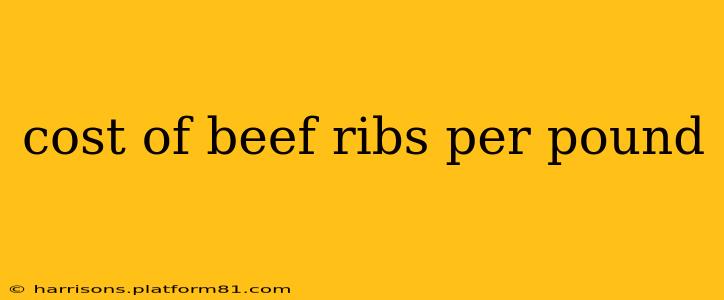The Cost of Beef Ribs Per Pound: A Comprehensive Guide
The cost of beef ribs per pound can vary significantly depending on several factors. Understanding these factors will help you budget effectively and make informed choices when purchasing this delicious cut of meat. This guide will explore the price fluctuations and provide you with a clearer picture of what to expect.
Factors Affecting the Price of Beef Ribs:
Several key elements influence the final price you'll pay for beef ribs per pound:
-
Type of Beef Ribs: There are two main types: bone-in short ribs and bone-in back ribs. Short ribs, known for their rich marbling and intense flavor, generally command a higher price per pound than back ribs, which are leaner and often more affordable. Within these categories, further variations exist (e.g., English cut vs. Flanken cut short ribs).
-
Grade of Beef: The USDA grading system (Prime, Choice, Select) directly impacts the price. Prime ribs, with the highest marbling, will be the most expensive, followed by Choice, and then Select. Supermarkets often carry Choice and Select, while higher-end butchers may offer Prime.
-
Retailer: Prices can differ dramatically based on where you buy your ribs. High-end butcher shops will often charge more than supermarkets, reflecting the quality of their meat and potential extra services like custom cuts. Smaller, local butcher shops may also offer competitive pricing and personalized service.
-
Geographic Location: Depending on your region, the cost of beef ribs can fluctuate due to factors like local demand, transportation costs, and the prevalence of cattle ranching in the area.
-
Seasonality: While less pronounced than with some produce, there may be slight seasonal variations in beef prices.
-
Demand and Supply: Like any commodity, fluctuations in the overall beef market due to supply chain issues, weather events, or changes in consumer demand will impact pricing.
How Much Do Beef Ribs Typically Cost?
Providing an exact price per pound is difficult due to the variability mentioned above. However, you can expect a general range:
- Select Grade Back Ribs: Might range from $5 to $8 per pound.
- Choice Grade Back Ribs: Typically cost between $8 to $12 per pound.
- Choice Grade Short Ribs: Often fall in the range of $10 to $15 per pound, sometimes higher.
- Prime Grade Short Ribs: Expect to pay $15 or more per pound for this premium cut.
Where to Find the Best Deals on Beef Ribs?
- Supermarkets: Regularly check weekly flyers for sales and discounts.
- Bulk Buying: Consider purchasing larger quantities if you're planning a big event, as this often results in cost savings per pound.
- Local Butcher Shops: While potentially more expensive upfront, these shops often offer higher quality meat and personalized service.
- Meat Markets: Specializing in various cuts of meat, these establishments might offer competitive pricing, particularly on larger quantities.
What are the Different Cuts of Beef Ribs?
This is a key question when understanding cost. Short ribs and back ribs are the most common types, with variations within those. The type of cut will impact both taste and price. For example, English-style short ribs are bone-in and often thicker than flanken short ribs, which are known for their unique texture.
How can I tell the difference between prime, choice and select beef ribs?
The USDA grading system uses a visual assessment of marbling (fat distribution within the lean meat) and other factors. Prime grade boasts the most marbling, leading to the richest flavor and tenderness, but also the highest price. Choice grade still has good marbling, while Select grade has the least. The difference in marbling is usually evident when comparing the cuts.
By understanding the factors influencing the price of beef ribs and by shopping smart, you can enjoy this flavorful meat while staying within your budget. Remember to always check with your local retailers for current pricing and available cuts.
